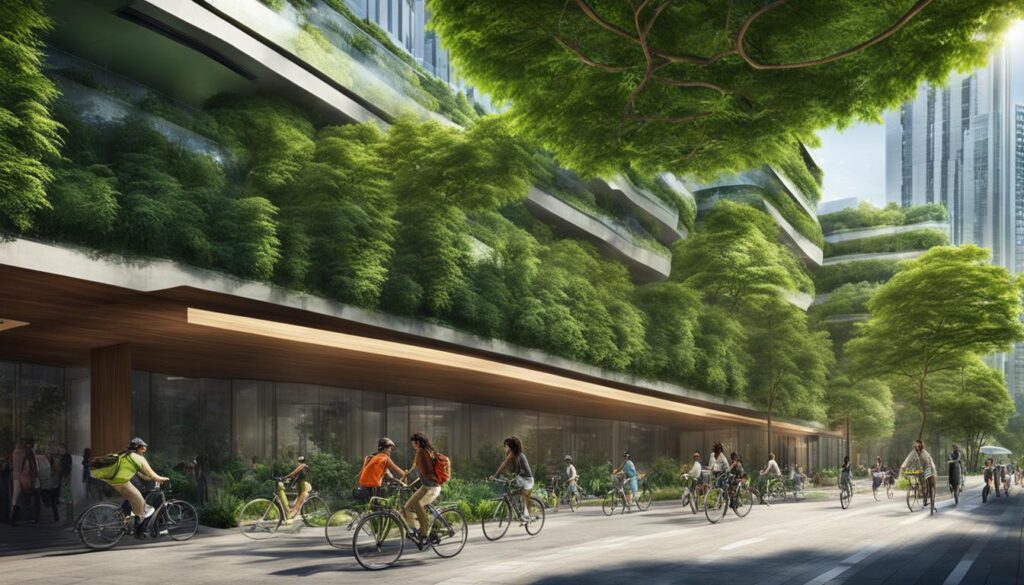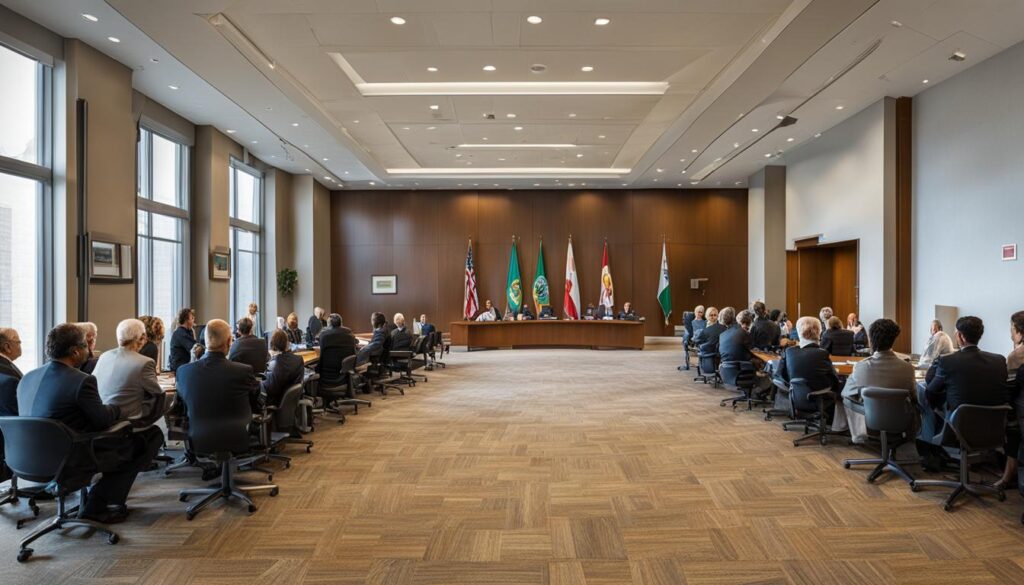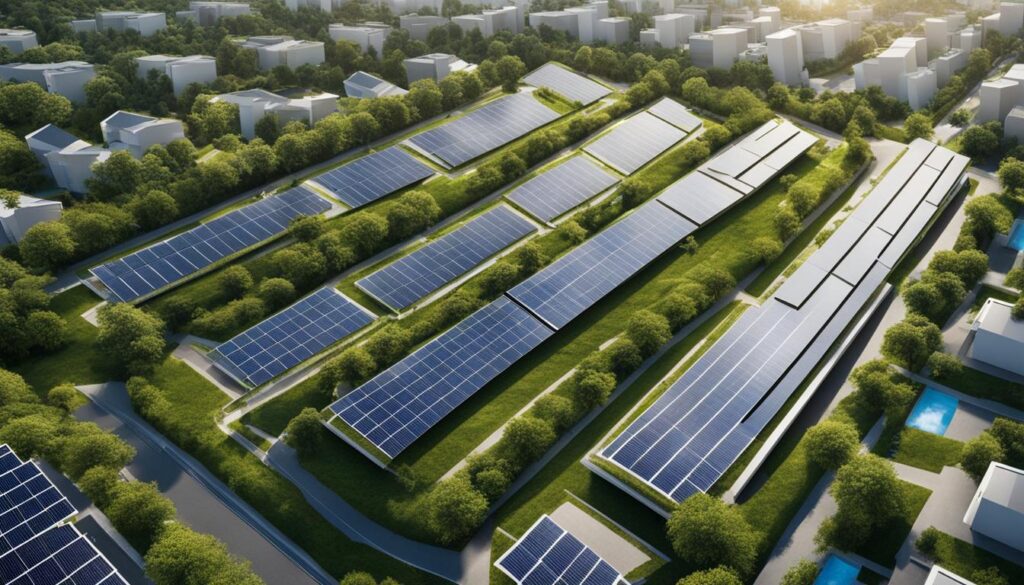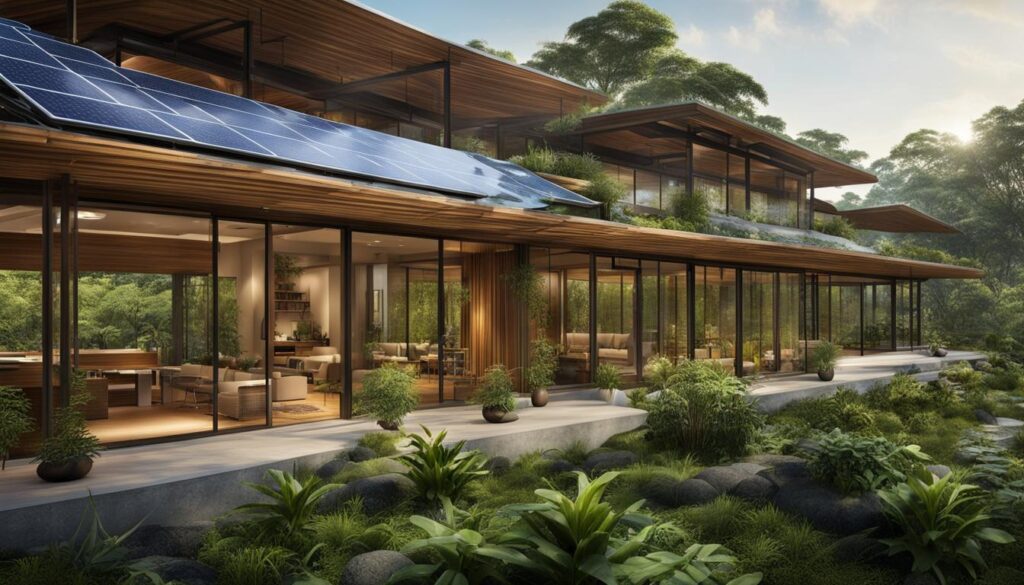G’day, mates! I’m here to tell you about the exciting strides being made by the East Gippsland Shire Council in the realm of Environmentally Sustainable Design (ESD). This forward-thinking council is taking a green step forward by incorporating ESD practices and sustainable building design into their decision-making processes.
ESD, as we Aussies know, is all about finding that perfect balance between social, economic, and environmental factors. And let me tell you, the East Gippsland Shire Council is nailing it! By integrating ESD principles into their strategic planning instruments, project design, and environmental assessments, they are paving the way for a greener future.
So, what does this mean for our mates in East Gippsland? Well, it means they can expect to see more environmentally friendly development projects, a greater emphasis on conservation and biodiversity, and a commitment to sustainable practices that will benefit generations to come.
Key Takeaways:
- East Gippsland Shire Council is embracing ESD practices and sustainable building design
- ESD principles are being incorporated into strategic planning, project design, and environmental assessments
- The council’s efforts will result in more environmentally friendly development projects
- Conservation of biodiversity and sustainability are key focuses of East Gippsland Shire Council
- This green step forward will benefit current and future generations
The Growth of Sustainable Development as a Global Ideal
The concept of sustainable development, defined as meeting the needs of present generations without compromising the ability of future generations to meet their own needs, has gained international recognition and become a global ideal. This journey towards sustainability began with the landmark Brundtland Report, which emphasized the importance of addressing environmental challenges in a holistic and integrated manner. The report laid the foundation for global strategies to promote sustainable development.
Subsequent milestones in the journey towards sustainability include the Rio Declaration, Agenda 21, and various World Summits that further advanced the principles of sustainable development. These international agreements and action plans have played a crucial role in raising awareness, promoting collaboration, and driving policy changes to address environmental and social issues on a global scale.
The Montevideo Programme is another significant contribution to the growth of sustainable development as a global ideal. It emphasized the importance of ecosystem evaluation and environmental assessments in policy-making, highlighting the need for a comprehensive understanding of the impacts and potential risks associated with development projects.
Together, these initiatives have paved the way for a more sustainable future by fostering a global understanding of the interconnectedness between environmental, social, and economic factors. They serve as a reminder that sustainable development is not just an individual effort but a collective responsibility that requires collaboration, innovation, and ongoing commitment from all stakeholders.

References:
- Brundtland Report: https://sustainabledevelopment.un.org/content/documents/5987our-common-future.pdf
- Rio Declaration: https://www.unep.org/documents/10162/rio+declaration+on+environment+and+development/27f98d88-9efc-48e2-8e10-585c2be331f3
- Montevideo Programme: https://www.cbd.int/doc/publications/cbd-ts-17-en.pdf
ESD in Decision-making
Incorporating environmentally sustainable design (ESD) principles in decision-making processes is crucial for achieving sustainable development. While legal obligations may vary, decision-makers have the responsibility to weigh and balance the social, economic, and environmental components of ESD. The principles of ESD can guide decision-makers in making informed choices that prioritize sustainability.
When incorporating ESD in decision-making, it is important to consider the priorities and weightings of each component. Balancing these priorities is an executive function that may be subject to judicial review. While legislation may not explicitly refer to ESD, decision-makers can still consider its principles and apply them in their decision-making processes.
ESD in decision-making requires a thoughtful approach that takes into account the long-term implications and consequences of our actions. By considering the principles of ESD, decision-makers can make choices that promote sustainability and contribute to a greener future.
Furthermore, decision-makers must also consider the public interest when making decisions that impact the environment. Legislation may impose requirements to consider principles of ESD based on the public interest, ensuring that decisions align with sustainable practices.
ESD Principles in Decision-making:
- Integrating social, economic, and environmental considerations
- Balancing priorities to achieve sustainable outcomes
- Considering long-term impacts and consequences
- Promoting the public interest and sustainability

In conclusion, incorporating ESD principles in decision-making is essential for promoting sustainable development. By considering the social, economic, and environmental components of ESD and balancing priorities, decision-makers can make informed choices that prioritize sustainability. Legal obligations may vary, but the guiding principles of ESD can provide valuable guidance for decision-makers in their pursuit of environmentally conscious decision-making.
Practical Application of ESD
Incorporating Environmentally Sustainable Design (ESD) principles in decision-making processes is essential for promoting sustainable development. In this section, we will explore the practical application of ESD in strategic planning, project design, environmental assessment, and government procurement practices.
Strategic Planning
Strategic planning plays a crucial role in ensuring that sustainability is integrated into the development process from the very beginning. By considering ESD principles during strategic planning, decision-makers can identify opportunities to minimize environmental impacts and maximize sustainable outcomes. This involves conducting in-depth research, analyzing environmental data, and setting clear sustainability goals to guide the decision-making process.
Project Design
ESD principles should be incorporated into project design to ensure that sustainable practices are implemented at every stage of development. This includes utilizing energy-efficient technologies, incorporating renewable materials, and designing buildings and infrastructure that minimize resource consumption and waste generation. By employing innovative design strategies, such as passive cooling and natural lighting, projects can reduce their environmental footprint while providing a comfortable and healthy environment for occupants.
Environmental Assessment
Environmental assessment is a critical tool for evaluating the potential environmental impacts of development projects and identifying appropriate mitigation measures. By conducting thorough environmental assessments, decision-makers can identify potential risks and develop strategies to minimize or offset them. This process involves analyzing the project’s impact on air quality, water resources, biodiversity, and ecosystems, among other factors, and developing measures to minimize or mitigate any adverse effects.
Government Procurement
Government procurement practices that prioritize ESD principles can significantly contribute to sustainable development. By incorporating sustainability criteria into procurement processes, governments can encourage the adoption of environmentally friendly practices and products. This includes considering the lifecycle impacts of materials and products, favoring suppliers with strong environmental credentials, and supporting the development of sustainable industries.

In summary, the practical application of ESD in decision-making processes involves integrating sustainability into strategic planning, project design, environmental assessment, and government procurement practices. By implementing ESD principles in these areas, we can promote sustainable development and create a greener and more sustainable future.
Using the Precautionary Principle
When it comes to the protection of our environment, it’s always better to be safe than sorry. That’s where the Precautionary Principle comes in. By taking a cautious and preventative approach, we can address potential risks of environmental degradation caused by development projects. The Precautionary Principle acts as a guiding principle for decision-makers, urging them to consider the long-term implications of their actions and prioritize the well-being of our planet.
One effective way to implement the Precautionary Principle is through adaptive management. By making adaptive management a condition of development consent, we ensure that project impacts are continuously monitored and mitigated. This approach allows for flexibility and responsiveness, enabling us to adapt our strategies as new information emerges. Through constant monitoring and proactive measures, we can minimize the potential harm to our environment and preserve it for future generations.
“In the face of uncertainty and potential harm, caution and prevention should be our guiding principles for environmental protection.”
The Precautionary Principle reminds us that we have a shared responsibility to protect our environment and promote sustainability. By approaching development projects with caution and prevention in mind, we can safeguard our natural resources and maintain ecological balance. Together, let’s take the necessary steps to ensure a greener and more sustainable future for all.
| Precautionary Principle | Adaptive Management | Caution and Prevention |
|---|---|---|
| Guiding principle for decision-making | Continuous monitoring and mitigation | Protecting our environment |
| Prioritizes long-term implications | Flexibility and responsiveness | Preserving natural resources |
| Ensures sustainable practices | Minimizes potential harm | Promoting ecological balance |
Intergenerational Equity
When it comes to embracing environmentally sustainable practices, ensuring intergenerational equity is of utmost importance. Intergenerational equity refers to the fair distribution of resources and benefits across different generations, ensuring that the needs of the present generation are met without compromising the ability of future generations to meet their own needs.
Conservation of biodiversity plays a vital role in achieving intergenerational equity. Biodiversity refers to the variety of plants, animals, and other organisms that exist in a particular ecosystem. By safeguarding and preserving biodiversity, we are ensuring that future generations can enjoy the same diverse and thriving natural world that we do today.
Equally crucial is the preservation of ecological integrity. Ecological integrity refers to the health and resilience of ecosystems, the balance of natural processes, and the ability of ecosystems to sustain diverse plant and animal communities. By maintaining ecological integrity, we are safeguarding the long-term viability and functionality of our ecosystems, securing a sustainable future for generations to come.
“Intergenerational equity is not about leaving behind a legacy, but rather about being responsible stewards of the environment that we share with future generations.”
The Importance of Intergenerational Equity
Ensuring intergenerational equity is essential for creating a sustainable future. By prioritizing the conservation of biodiversity and maintaining ecological integrity, we can guarantee that our actions today do not compromise the well-being and opportunities of future generations.
| Benefits of Intergenerational Equity in ESD | Examples |
|---|---|
| Preserves natural resources for future generations | – Conserving forests and maintaining sustainable timber practices. |
| Promotes sustainability and resilience | – Implementing renewable energy sources to reduce our reliance on fossil fuels. |
| Creates a legacy of responsible environmental stewardship | – Establishing protected areas and national parks to safeguard biodiversity. |
- Conservation of biodiversity
- Maintenance of ecological integrity
- Preservation of natural resources
- Reducing our ecological footprint
By upholding the principles of intergenerational equity, we can forge a path towards sustainable development that not only benefits the present but also ensures a brighter future for generations to come.
Improved Valuation, Pricing, and Incentive Mechanisms
Valuation, pricing, and incentive mechanisms are integral to promoting sustainability. By accurately assessing the value of natural resources and incorporating their ecological services into cost calculations, we can prioritize sustainable practices that benefit both the environment and the economy. Additionally, implementing incentive programs can further encourage individuals and businesses to adopt environmentally friendly behaviors and technologies. Sustainability financing is key to ensuring the success and longevity of these initiatives.
Valuation: When it comes to sustainability, accurately valuing natural resources is crucial. By recognizing their worth beyond immediate economic gains, we can properly account for their environmental, social, and cultural significance. Valuing ecosystems, such as forests and wetlands, helps us understand their contribution to climate regulation, water purification, and biodiversity preservation.
Pricing: Pricing mechanisms play a vital role in encouraging sustainable practices. By incorporating the true cost of resource usage, such as carbon emissions or water consumption, into the pricing of goods and services, we can incentivize individuals and businesses to choose alternatives that have a lesser environmental impact. For example, higher prices on carbon-intensive products can drive the demand for renewable energy sources and low-carbon technologies.
Quote: “Pricing mechanisms can effectively internalize the external costs associated with unsustainable resource use, leading to more sustainable consumption and production patterns.” – Dr. Jane Green
Incentive Mechanisms: Incentives, such as tax breaks, grants, or subsidies, can greatly influence behavior and drive the adoption of sustainable practices. Governments and organizations can provide financial incentives to individuals and businesses that demonstrate environmental responsibility. For instance, offering tax credits for energy-efficient upgrades in buildings incentivizes sustainable building design and supports the transition to a greener future.
In summary, improved valuation, pricing, and incentive mechanisms are essential tools for promoting sustainability. By accurately valuing natural resources, incorporating true costs into pricing mechanisms, and offering incentives for sustainable practices, we can create a culture of environmental responsibility and encourage the transition towards a more sustainable future.

Table: Examples of Sustainable Incentive Programs
| Program | Description | Benefits |
|---|---|---|
| Renewable Energy Feed-In Tariff | A program that encourages the generation of renewable energy by providing a guaranteed price for electricity fed back into the grid. | Reduces reliance on fossil fuels, promotes investment in renewable energy infrastructure, and creates jobs in the renewable energy sector. |
| Green Building Certification Rebates | Rebates provided to building owners who meet specific sustainability criteria, such as energy efficiency, water conservation, and use of environmentally friendly materials. | Encourages sustainable building practices, reduces energy consumption, and improves indoor air quality and occupant health. |
| Electric Vehicle Purchase Incentives | Financial incentives, such as tax credits or rebates, offered to individuals or businesses purchasing electric vehicles (EVs). | Boosts the adoption of EVs, reduces greenhouse gas emissions from transportation, and promotes a shift towards cleaner modes of transportation. |
| Water Conservation Grants | Grants provided to individuals, businesses, or communities implementing water-efficient technologies or practices, such as rainwater harvesting or water-saving irrigation systems. | Reduces water consumption, supports sustainable water management, and helps secure water resources for future generations. |
ESD Guidelines in East Gippsland Shire Council
When it comes to promoting sustainable development and environmental initiatives, the East Gippsland Shire Council has taken a proactive approach by implementing ESD guidelines. These guidelines are designed to ensure that development projects within the council align with sustainable practices, specifically focusing on green infrastructure planning and energy-efficient design.
Through green infrastructure planning, the council aims to create a more sustainable and resilient community by enhancing natural systems. This includes strategies such as implementing urban greening initiatives, promoting biodiversity conservation, and integrating sustainable water management practices. By incorporating these principles into their guidelines, the council is prioritizing the protection and improvement of the local environment.
Energy-efficient design is another key aspect of the ESD guidelines implemented by the East Gippsland Shire Council. By encouraging the use of energy-efficient technologies and practices in building design, the council is taking steps towards reducing energy consumption and greenhouse gas emissions. This can include measures such as passive design strategies, energy-efficient appliances, and renewable energy systems. By championing energy-efficient design, the council is leading the way in creating a more sustainable built environment.
| Benefits of ESD Guidelines in East Gippsland Shire Council |
|---|
| 1. Promotes sustainable development |
| 2. Enhances natural systems and biodiversity |
| 3. Reduces energy consumption and greenhouse gas emissions |
| 4. Creates a more resilient and sustainable community |
With their ESD guidelines, the East Gippsland Shire Council is paving the way for sustainable development and environmental stewardship. By emphasizing green infrastructure planning and energy-efficient design, the council is not only taking responsibility for the present, but also ensuring a greener and more sustainable future for the community.
Sustainable Building Design and Eco-Friendly Architecture
When it comes to creating a greener future, sustainable building design and eco-friendly architecture are at the forefront of innovation. These practices not only prioritize environmental responsibility but also offer numerous benefits for both individuals and communities. By incorporating energy-efficient systems, renewable materials, and passive design strategies, buildings can minimize their environmental impact and contribute to a sustainable future.
Sustainable building design goes beyond just using eco-friendly materials; it encompasses a holistic approach that considers the entire life cycle of a building. From construction to maintenance and eventual demolition, every aspect is carefully considered to optimize resource efficiency and reduce waste. This approach results in long-term cost savings, improved indoor air quality, and reduced energy consumption, making it an attractive proposition for both developers and occupants.
The Benefits of Sustainable Building Design
- Reduced greenhouse gas emissions: Sustainable buildings prioritize energy efficiency, reducing reliance on fossil fuels and thereby lowering carbon emissions.
- Improved indoor comfort: Passive design strategies, such as strategic window placement and natural ventilation, enhance thermal comfort, reducing the need for excessive heating or cooling.
- Enhanced resource efficiency: By utilizing renewable materials, implementing rainwater harvesting systems, and incorporating efficient waste management practices, sustainable buildings minimize their impact on natural resources.
- Health and well-being: Sustainable designs often prioritize natural lighting, access to green spaces, and toxin-free materials, creating healthier and more comfortable living environments.
- Long-term cost savings: Energy-efficient systems, such as solar panels and efficient insulation, can significantly reduce utility bills over time, making sustainable buildings cost-effective in the long run.
As we look towards a future that demands environmental responsibility, sustainable building design and eco-friendly architecture offer solutions that go beyond aesthetics. These practices are shaping the way we build and live, creating spaces that not only meet our present needs but also preserve the planet for future generations.
| Year | Number of Sustainable Buildings |
|---|---|
| 2015 | 312 |
| 2016 | 478 |
| 2017 | 624 |
| 2018 | 812 |
Table: Number of Sustainable Buildings in East Gippsland Shire Council (Source: East Gippsland Shire Council Annual Report)
With advancements in technology, innovative design solutions, and growing awareness of the impact of our built environment, sustainable building design and eco-friendly architecture are becoming the norm rather than the exception. By embracing these practices, we can not only reduce our carbon footprint but also create healthier, more vibrant communities and pave the way for a greener and more sustainable future.
Conclusion: A Green Step Forward
Ah, the sweet smell of progress! East Gippsland Shire Council is taking a giant leap towards a sustainable future with its embrace of Environmentally Sustainable Design (ESD). By incorporating ESD principles in decision-making processes, this council is paving the way for truly sustainable development projects and groundbreaking environmental initiatives.
From the strategic planning stage to project design and environmental assessments, ESD is the guiding star. It’s like having a built-in eco-conscious compass, ensuring that every step is taken with the environment in mind. This commitment to sustainable building design sets a new standard, as eco-friendly architecture and green building solutions become the norm rather than a fancy addition.
But it doesn’t stop there. East Gippsland Shire Council understands the value of our natural resources and the importance of conserving biodiversity. By recognizing the worth of our environment and incorporating it into valuation, pricing, and incentive mechanisms, they’re putting their money where their green heart is. Who knew finance could be so sustainable?
So, let’s raise a glass (filled with locally sourced, organic, and fair-trade juice, of course) to East Gippsland Shire Council for embracing ESD, promoting sustainable development projects, and spearheading remarkable environmental initiatives. With their commitment to a greener tomorrow, they’re proving that progress doesn’t have to come at the expense of our beautiful planet.
FAQ
What is Environmentally Sustainable Design (ESD)?
ESD is the concept of meeting the needs of present generations without compromising the ability of future generations to meet their own needs.
How has sustainable development gained international attention?
Sustainable development gained international attention through the Brundtland Report, followed by the Rio Declaration, Agenda 21, and World Summits that further promoted its principles.
What are the priorities and weightings of the various components of ESD determined by?
The priorities and weightings between the social, economic, and environmental components of ESD are determined by the decision-maker.
How can ESD be incorporated in decision-making?
ESD can be incorporated in decision-making through strategic planning instruments, project design, and environmental assessments.
How can the precautionary principle be used in addressing environmental risks?
The precautionary principle can be used to address potential risks of environmental degradation caused by development projects.
What is intergenerational equity in the context of ESD?
Intergenerational equity aims to ensure that the needs of the present generation are met without compromising the ability of future generations to meet their own needs.
How can improved valuation, pricing, and incentive mechanisms promote sustainability?
Improved valuation, pricing, and incentive mechanisms can prioritize sustainable practices by accurately valuing natural resources and providing incentives for environmentally friendly practices.
How has East Gippsland Shire Council embraced ESD?
East Gippsland Shire Council has implemented ESD guidelines, incorporating principles of green infrastructure planning and energy-efficient design.
How does sustainable building design contribute to ESD?
Sustainable building design, through energy-efficient systems, renewable materials, and passive design strategies, minimizes environmental impact and supports sustainable development.
How is East Gippsland Shire Council leading in environmental initiatives and sustainable development?
By implementing ESD principles in decision-making, incorporating sustainable building design, and valuing the conservation of biodiversity, East Gippsland Shire Council is taking a green step forward in environmental initiatives and sustainable development projects.
Source Links
- https://envcomm.act.gov.au/wp-content/uploads/2020/08/An-Expert-Paper-on-ESD-by-Gerry-Bates-for-Commissioner-May-2014.pdf
- https://lec.nsw.gov.au/documents/speeches-and-papers/preston_climate change litigation – a conspectus.pdf
- https://researchdirect.westernsydney.edu.au/islandora/object/uws:22669/datastream/PDF/view
